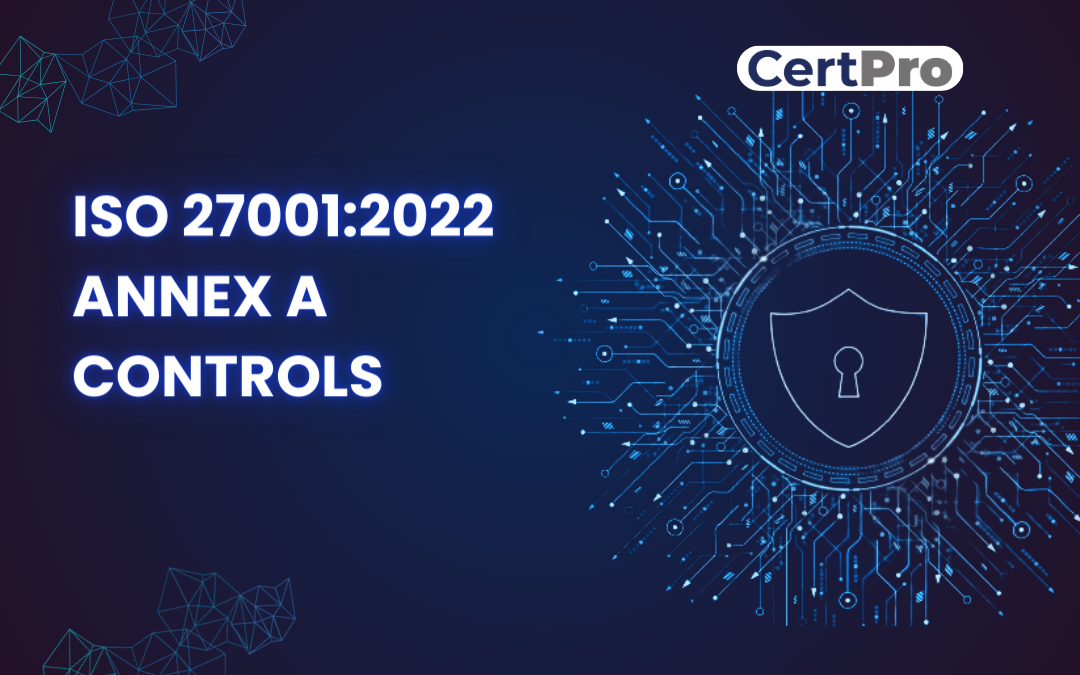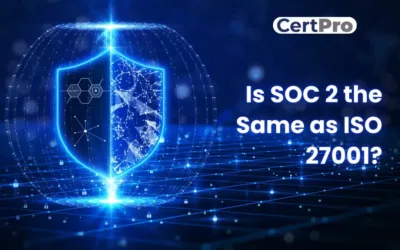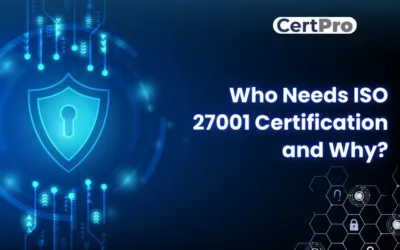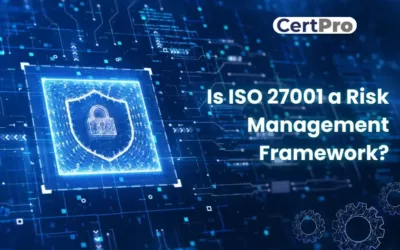Organizations face more difficulties related to digital transformation and cyber security in the modern world. Protecting sensitive data from cybersecurity attacks is now a concern. In addition, we find continuous headlines on data breaches and cyberattacks. Now, the whole business world is thriving in protecting their valuable information. Therefore, many businesses apply internationally recognized standards to enhance security, and the ISO 27001 update 2022 provides better protection.
Furthermore, ISO 27001 update 2022 developed and maintained an Information Security Management System (ISMS). Hence, ISO 27001, Annex A, is in the standard lists related to the organization’s security controls following ISO 27001. On February 15, 2022, ISO 27001:2022 Annex A was formed to control various security and information concerns.
This article discusses ISO 27001 Annex A controls, tries to understand the always-changing information security landscape, and ensures data security. Similarly, we recognize and compare the changes between ISO 27001:2022 and ISO 27001:2013.
HOW ISO 27001 CAN AFFECT ORGANIZATIONS?
WHAT ARE THE CATEGORIES FOUND IN ISO 27001 ANNEX A CONTROLS?
HOW DOES ISO 27001:2022 FROM ITS PREDECESSOR, ISO 27001:2013?
HOW ISO 27001:2022 ANNEX IMPLEMENTATION CAN AFFECT AN ORGANIZATION?
WHAT IS A STATEMENT OF APPLICABILITY (SOA)
WHO IS RESPONSIBLE FOR IMPLEMENTING ISO 27001 CONTROLS?
PDCA: A GUIDE FOR IMPLEMENTING ISO 27001:2022
NEED EXPERT HELP IN ORDER TO BE COMPLIANT WITH ISO 27001:2022?
WHAT IS ISO 27001:2022?
It is an information security management system (ISMS). Thus, the ISO 27001 standard improves data privacy and ensures data availability, confidentiality, and integrity. Therefore, ISO 27002:2022 controls are the new and third version of the ISO 27001 standard. Thus, it offers recommendations and best practices for implementing information security measures.
WHAT IS ISO 27001 ANNEX A?
Additionally, ISO 27001 Annex A is essential for an organization to ensure its information security procedures. Therefore, ISO 27001 Annex A controls are intended to recognize your organization’s information security-related threats and weaknesses. Hence, it can benefit your organization as it helps identify the risks and establish a security baseline. Thus, the processes can be customized to your organization’s demands and needs. Again, the following steps are used for the implementation of ISO 27001 Annex A controls:
- Risk Assessment: In this respect, ISO 27001 Annex A helps identify potential risks and analyze possible threats from certain risks.
- Control Selection: It helps control and mitigate the potential risks in your organization.
- Control Implementation: It can help you execute procedures and policies and implement strategies to avoid possible risks.
- Monitoring and Evaluation: In this respect, ISO 27001 Annex A helps monitor and evaluate the efficacy of implemented policies and strategies.
- Audits and Reviews: Internal audits and reviews are conducted to understand the efficacy of the ISMS.
- Continuous Improvement: Work on threat areas based on audit reports and reviews.
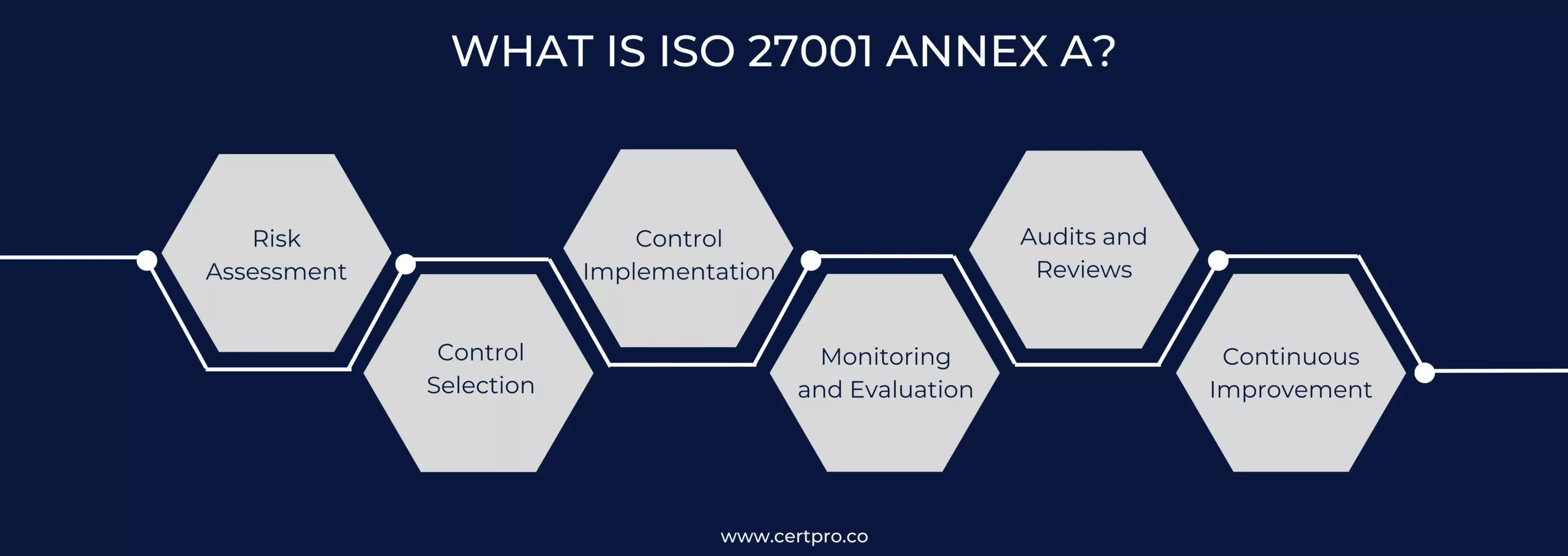
HOW ISO 27001 CAN AFFECT ORGANIZATIONS?
The implementation of ISO 27001 within your company not only communicates your dedication to strong security procedures but also provides comfort to current customers. By being proactive, you can reassure clients that your company will always take the appropriate security precautions to protect their private information, which helps to keep them as customers. Moreover, implementing ISO 27001 improves your attractiveness to prospective customers who appreciate working with a company committed to proactive data protection.
It is important to emphasize that implementing ISO 27001 requires continuous maintenance rather than being a one-time exercise. This continuous commitment guarantees that your security program will adapt each year to suit these objectives and stay up-to-date with new developments in data protection. Businesses that engage in this ongoing process will profit greatly, building more brand equity, especially with consumers looking for strong data protection. Organizations that adopt ISO 27001 set themselves up for long-term success, gaining the trust of their customers and drawing in new business.
WHAT ARE THE CATEGORIES FOUND IN ISO 27001 Annex A CONTROLS?
Henceforth, you can find 14 categories, each of which deals with different areas of information security. Consequently, the ISO 27001:2022 controls are created to implement, maintain, and improve your business’s information security management system (ISMS). Therefore, the ISO 27001:2022 Annex A Controls categories are as follows:
1. A.5 Information Security Policies: It can help you define, document, and communicate the organization’s policies.
2. A.6 Organization of Information Security: In this segment, they consider the organizational structure for managing information security.
3. A.7 Human Resource Security: This category concerns managing your company’s security. It considers information about employees, contractors, and third-party users.
4. A.8 Asset Management: This category concerns understanding your organization’s inventory, handling process, and assets.
5. A.9 Access Control: It aims to authorize access to information and resources. It also prevents unauthorized access to information.
6. A.10 Cryptography: It considers using cryptographic techniques for protecting your information.
7. A.11 Physical and Environmental Security: Such controls consider the physical protection of data and equipment from your end.
8. A.12 Operations Security: The controls monitor the daily operation system for your organization.
9. A.13 Communications Security: Such controls provide security to your networks and communication channels
10. A.14 System Acquisition, Development, and Maintenance: In this category, concentration is given to the maintenance &development of your organization’s information systems.
11. A.15 Supplier Relationships: Such controls should consider the third-party relationships of your company in managing security.
12. A.16 Information Security Incident Management: It is crucial to manage controls and reporting related to information security incidents in your organization.
13. A.17 Information Security Aspects of Business Continuity Management: It aims to ensure your business continuity and availability of critical information.
14. A.18 Compliance: It addresses your organization’s regulatory, contractual, and internal information security requirements.
Moreover, companies can implement specific procedures and practices. Thus, companies may create a solid and efficient ISMS to increase security. Furthermore, adopting and adapting these rules to their unique context will reduce exposure to information security threats.
HOW DOES ISO 27001:2022 FROM ITS PREDECESSOR, ISO 27001:2013?
Now, we will discuss the changes and effectiveness of the new ISO 27001:2022 version. Let’s delve into more information to determine whether the ISO 27001:2022 security controls list is up to the mark.
Both ISO 27001:2022 and ISO 27001:2013 have the same number of clauses. However, the text has changed slightly to align with other standards related to ISO 27001. Hence, the main changes are observed in planning, defining the criteria, and monitoring the standards. Furthermore, structural changes were made in Annex A controls, along with reducing the number of controls. In a simple way:
- Added 11 new controls
- Thus, merged 57 controls
- Furthermore, renamed 23 existing controls
- Again, 3 controls are removed
On the other hand, ISO 27001:2013 has 14 domains that have changed in ISO 27001:2013 Annex A. Now, four themes are available instead of multiple domains, which include:
- Organizational Controls (37 controls)
- People Controls (8 controls)
- Physical Controls (14 controls)
- Technological Controls (34 controls)
Some new security controls that have been added to ISO 27001:2022 are:
- A.5.7 Threat Intelligence
- A.5.23 Security of Data
- A.5.30 ICT Readiness for Business Continuity
- A.7.4 Physical Security Monitoring
- A.8.9 Configuration Management
- A.8.10 Information Deletion
- A.8.11 Data Masking
- A.8.12 Data Leakage Prevention
- A.8.16 Monitoring Activities
- A.8.23 Web Filtering
- A.8.28 Secure Coding
HOW ISO 27001:2022 ANNEX IMPLEMENTATION CAN AFFECT AN ORGANIZATION?
The implementation of ISO 27001:2022 Annex A within your company not only shows your interest in security procedures. Also, it provides comfort to current customers and enhances your market acceptance. It ensures your customers that your company is considering data security seriously and taking all necessary actions to protect their personal information. Additionally, it can positively impact your potential customers and convert them into actual customers. Always remember that implementing ISO 27001:2022 requires continuous monitoring and maintenance. Thus, constant monitoring ensures that your organization follows data security implementation properly. Therefore, applying ISO 27001 controls can improve your business perspective and generate more profits. Consequently, to enhance your brand equity and business capabilities, go for ISO 27001. Thus, it will help you create trustworthy relationships with your customers.
WHAT IS A STATEMENT OF APPLICABILITY (SOA)
An essential document for ISO 27001 certification is the Statement of Applicability (SOA), which outlines the controls in ISO 27001 Annex A and their significance to a company. In addition to stating whether a control is applicable, the SOA details how the control is implemented, including relevant documentation and clearly stating which controls are inappropriate and why.
ISO 27001 Standard Clause 6.1.3 requires the SOA to list all controls responsive to identified risks and explain their reasoning. Thus, the techniques used to implement and reasons for any controls that have been left out. Because security controls are sensitive, organizational management must confidently examine and approve the SOA. This is a necessary step toward certification.
Completing the SOA requires a thorough understanding of an organization’s activities and is time-consuming. A well-executed SOA, however, usually requires yearly evaluations and very few changes.
A five-step process guides the development of the SOA:
1. Comprehend ISO 27001 Requirements and Controls: Completely understand ISO 27001 requirements and controls, referencing ISO 27002 as needed.
2. Conduct Risk Assessment: Create an inventory of information assets and rank security threats based on likelihood and impact.
3. Complete the Risk Treatment Plan: Document responses to detected threats. Therefore, awareness of the ISO 27001 security control list can help maintain compliance.
4. Select Applicable ISO 27001 Controls: Identify controls appropriate to the organization based on the risk management plan and security measures in place.
5. Prepare the Statement of Applicability: Understand the extent of the Information Security Management System, including assets, risk assessments, and treatment plans. For the whole process, ISO standards and Annex A controls should be used in collaboration with HR, IT, and other departments.
WHO IS RESPONSIBLE FOR IMPLEMENTING ISO 27001 CONTROLS?
A commonly held misunderstanding claims that the responsibility for implementing ISO 27001 controls within a business rests exclusively with IT. This is untrue; organizational, physical security, human resources, and legal issues comprise the remaining controls, with technology making up a small percentage of them.
The task of implementing Annex Controls should be dispersed among different stakeholders and departments within an organization. The size, complexity, and security posture of the organization determine which specific individuals will fill this role. It is critical to note that a collaborative approach involving different aspects of the organization is required for complete adherence to ISO 27001 requirements. This provides a comprehensive and effective implementation that extends beyond the boundaries of IT, recognizing the various factors required for strong information security management.
PDCA: A GUIDE FOR IMPLEMENTING ISO 27001:2022
The plan for PDCA implementation is discussed below:
PLAN
- Definition of Problems: Recognizing and defining the organization’s concerns is essential. Thus, it identifies the grasp of the current issues.
- Setting Goals: Implementing an information security framework requires a goal and objectives. Therefore, a clear vision regarding the implementation and output of ISMS is necessary.
- Choice of Methods: The techniques and approaches should be appropriate per the organization’s needs. In addition, the set objectives require proper consideration. In this instance, emphasize the implementation of ISO 27001 as a complete framework.
DO
- Practice the Method: Implement the selected ISMS method, following ISO 27001 guidelines. Hence, it entails carrying out the intended plans, adding pertinent policies, and starting projects. Consequently, the whole process is working toward strengthening information security.
- Execute: Executing the scheduled operations processes is essential. Likewise, it ensures the smooth implementation of the selected ISMS procedure. To improve the organization’s information systems, put rules, methods, and other components found during the planning stage into action.
- Make Changes: Adapt to the changing environment. Be willing to make the required modifications and enhancements based on user input and new information as the implementation progresses.
CHECK
- Measure and Record Results: Methodically record the installed ISMS’s outcomes. Employ performance metrics to evaluate information security measures’ efficacy and ensure they meet predetermined objectives.
- Check for Deviations: Conduct regular checks to find any alterations from the intended action sequence. Look for disparities in the ISMS deployment and swiftly resolve them.
- Root Cause Analysis: If any problems or deviations are found, investigate their underlying causes. Therefore, a thorough examination must be performed to identify the fundamental causes of information security issues.
ACT
- Corrective Actions: Take corrective action following the root cause analysis’s conclusions. Therefore, you might be able to recognize the risks and mitigate them, thus improving the overall information security posture.
- Improve the Work System: Thus, continuously improve the information security system to strengthen the work system. Therefore, an adaptable work system can mitigate threats and risks.
- Solutions for Desired Results: Make recommendations and implement plans. Again, this entails incorporating innovations and continuously improving information security inside the company.
NEED EXPERT HELP TO BE COMPLIANT WITH ISO 27001:2022?
ISO 27001:2022 compliance is a complex process that may require expert support. Therefore, CertPro can help you with this. Our experts can guide your organization to compliance with ISO 27001:2022. In addition, our skilled professionals will closely monitor the whole process of ongoing compliance. Thus, with CertPro, you can implement a robust information security framework within your organization and improve its security measures.
FAQ
How long does it take to get ISO 27001 certification?
It depends on the organization’s size and complexity. However, the certification can take 2 to 3 months, and sometimes, it can take six months.
WHAT DISTINGUISHES ANNEX A OF ISO 27002 FROM ISO 27001?
ISO 27002 considers implementing multiple controls to strengthen information security measures, while ISO 27001 only refers to the global security management standard.
Does ISO 27001 cover cyber security?
Yes. ISO 27001 is considered your organization’s cybersecurity. It also provides an information security framework that manages cyber security and information security risks.
Does ISO 27001 cover GDPR?
GDPR is all about securing personal data. In addition, ISO 27001 refers to information security standards that cover the organization’s overall security, including the handling and management of personal data. Thus, ISO 27001 covers the partial requirements of GDPR
How can CertPro help your organization with ISO 27001 COMPLIANCE?
CertPro has skilled professionals, and their expert guidance ensures hassle-free compliance with ISO 27001:2022 standards. Therefore, collaboration with CertPro can reduce your time and effort.

About the Author
ANUPAM SAHA
Anupam Saha, an accomplished Audit Team Leader, possesses expertise in implementing and managing standards across diverse domains. Serving as an ISO 27001 Lead Auditor, Anupam spearheads the establishment and optimization of robust information security frameworks.
IS SOC 2 THE SAME AS ISO 27001?
In today's digital landscape, ensuring the safeguarding of client data is paramount for businesses. Adhering to recognized compliance standards is vital to meeting this demand. ISO 27001 vs. SOC 2 represent two prominent benchmarks in the realm of data security with...
WHO NEEDS ISO 27001 CERTIFICATION AND WHY?
The esteemed ISO 27001 security framework is designed to evaluate the effectiveness of an organization's Information Security Management System (ISMS) in safeguarding its data. Obtaining ISO 27001 certification is a practical way for a corporation to demonstrate its...
IS ISO 27001 RISK ASSESSMENT VITAL FOR SECURITY MEASURES?
The ISO 27001 standard provides a framework for information security, highlighting the importance of a thorough risk assessment procedure. Organizations use the methodical and complex ISO 27001 risk assessment process to identify and assess information security...

